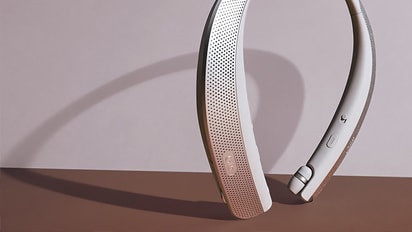At a Glance
Leaks from an LG washer are often easily resolved without a technician's support. The first step to fixing a leaking washing machine is to discover the source of the leak. After you have inspected the unit and identified the source, select an option from the list below.
If your machine is a Top Load Washer, please visit our article on Leaking - Top Load Washer.
Try This
Where is the source of the leak located?
-
Dispenser Leaks
Dispenser leaks are normally caused by the following:
-
Obstruction in the dispenser or dispenser compartment.
-
Detergent or additive buildup in the dispenser.
This can be resolved by cleaning the dispenser drawer. Debris or additive buildup can prevent detergent from dispensing properly and cause the compartment to overfill and leak.
-
Remove the detergent dispenser
- Fully extend the detergent dispenser drawer outward.
- Press down the PUSH button between the bleach and fabric softener compartments to release the detergent dispenser drawer.
- Carefully remove each compartment (lift the front side first as the tabs on the rear are delicate).
-
Clean the compartments and the dispenser drawer.
- Carefully remove each compartment (lift the front side first as the tabs on the rear are delicate).
- Once removed, wash thoroughly by hand with warm water and a soft sponge or towel to remove excess detergent or residue buildup.
- Use a wet towel or soft sponge to wipe away any detergent residue buildup inside the detergent dispenser drawer cavity.
- Once completed, let the compartments and drawer completely dry.
-
Reinstall the compartments and dispenser drawer back into the detergent cavity.
- Reassemble the compartment inserts and replace the detergent dispenser drawer back into the washer.
-
-
Door Leaks
Door leaks are caused by buildup of hair, lint or residue on the gasket or the inside door glass. Leaking can happen if the door gasket is damaged, leading to excessive leakage from the door.
How to fix main door leaks:
-
Inspect the door gasket for tears or damage.
NoteIf torn or damaged, request a repair with our 24/7 Chat Support.
-
Clean the door and door-gasket.
NoteDO NOT use straight bleach to clean the gasket, as this can cause the gasket to deteriorate over time.
- While wearing gloves, mix a cleaning solution of 3/4 cup bleach OR vinegar to 1 gallon of water.
- Wipe the inside door gently, from top to bottom, and around to the round edge where the door meets the gasket.
- With a cloth and the cleaning solution clean the surface of the door gasket.
- Pull the lip of the gasket back and clean underneath the lip of the gasket as well.
NoteWhen cleaning inside the gasket, be mindful to clean out any hair, lint, and/or detergent buildup.
-
Run tub cycle.
- If you see any hair, fabric threading or residue build up, remove it and run a tub clean cycle on your washing machine to check if the leaking stopped.
- If the rubber gasket is torn or damaged, or the door and gasket are clean but the leak persists, the unit requires a repair service. Request a repair with our 24/7 Chat Support.
-
-
Drain Filter
Leaks from the drain filter are normally caused by of two reasons: the manual drain hose cap is loose, or the drain pump filter is not seated or screwed on properly.
Show Script[LG Front Load Washers] How To Clean The Drain Pump Filter On Your LG Washer
Your LG front load washing machine is equipped with a drain pump filter that makes lost buttons and loose change a thing of the past. In this video, we will show you how to retrieve any lost items and keep your LG washer running properly for years to come. LG recommends cleaning out the drain pump filter of any lost items and lint buildup on a monthly basis.
Before we begin, make sure the unit is empty, turned off, and drained of any visible water in the tub. Locate the access panel on the lower front of your front load washer. Next, grab a shallow pan and have it ready by placing it near the access panel to collect the water. Open and remove the access panel by pulling the tab downward and out, revealing the drain hose and drain pump filter.
Pull the drain hose carefully into the pan and remove the plug from the hose, allowing the water to drain completely. Be careful not to pull the hose too far out as this can cause the hose to kink, preventing the water from draining properly. Once the water is drained, plug the drain hose and reinsert it back into place.
Next, remove the pump filter by turning the filter counterclockwise. Have a rag handy because a little bit of water will run out when the filter is removed. Remove lost items and any lint and debris from the pump filter. To clear any buildup, wash thoroughly by hand. When finished, reverse the process. Insert the pump filter back into its slot and turn clockwise until it stops, and finally, reinsert the access panel and close.
Please check your drain pump filter periodically, especially if you notice a slow drain where the display shows an OE error code. Thank you for watching our customer support video. We hope you enjoy your LG experience.
-
Turn off the washer.
-
Press the POWER button to turn off the unit and unplug it from the outlet.
-
-
Locate the service panel for the drain pump filter.
-
Find the service panel (drain filter area) located on the bottom-left corner of the unit and open it.
-
-
Drain out the excess water.
-
Inspect the drain hose to ensure it is not cracked or damaged.
-
Unclip the hose to the left of the drain pump, remove the cap and drain the excess water into a bucket or shallow pan.
NoteNote: The amount of water may vary according to when in the cycle the leak occurred.
-
-
Remove the drain filter.
-
After all excess water has been drained, twist the pump filter counter-clockwise to remove it from the washer.
-
-
Clean the drain pump filter and the base
-
With a soft-bristle brush and warm water, gently clean out any hair, lint or detergent residue.
-
Clean the filter opening and its base on the washing machine.
-
-
Reinsert the drain hose cap and reattach the drain hose to the washer.
-
Confirm that the drain hose is free of any tears, cracks or damage before reinserting the cap.
-
Ensure the drain hose is securely installed completely back into the washer.
-
-
Reinstall the drain pump filter.
-
Insert the drain pump filter back into the washing machine, making sure it is inserted securely.
-
When inserting the filter, make sure it is threaded correctly and tightened. It should stop turning once it is securely tightened.
NoteDO NOT over tighten the filter as doing so can damage the filter
-
-
Leaks from Safety Air Vent
Leaks from the “safety air vent” on the back of the washer occur when detergent residue has built up in the wash tub and on clothing.
If water or suds are seen leaking from the safety air vent located on the back of the washer or if large amounts of suds are visible in the tub during the wash cycle, try the steps below:
-
Confirm the detergent type.
-
It is recommended you ONLY use HE (high efficiency) detergents.
-
Concentrated HE detergent can leave a residue inside the machine which builds up and causes leaking from the safety air vent.
-
Non-HE detergent will cause over sudsing, leading to detergent remaining in the tub after the cycle or leakage from the safety air vent.
-
-
Reduce the amount of detergent and additives being used.
NoteDepending on your brand of detergent, IT IS NOT recommended to fill the detergent dispenser to the max line mark. Some detergents only require 1-2 tablespoons.
-
Follow the detergent guidelines from the manufacturer, however, it is recommended you reduce the amount used whenever suds remain after a wash.
-
The max fill line on the dispenser only indicates the amount of detergent that can be dispensed from the compartment.
-
If using fabric softener, it must be diluted with water to a 50/50 ratio.
-
Beware: Filling the fabric softener compartment to the max line can leave residue that causes leaking.
-
-
Perform a TUB CLEAN cycle.
-
A tub clean cycle should be performed at least once per month or more depending on wash frequency and the amount of detergent and additives being used.
-
If it has been some time since the last tub clean cycle, it may be necessary to perform tub cleaning 3 times back to back to break down the buildup.
-
Observe the unit for leaks after each tub clean cycle. If leaking persist after 3 tub cleans, request a repair with our 24/7 Chat Support.
-
Inlet Hoses and Valves
Leaks from the washer’s inlet hoses are mainly caused by loose or misthreaded hose connections, slightly damaged hoses, damaged connector washers or clogged inlet filters.
-
Turn off the water supply.
-
Inspect the inlet hoses.
-
Ensure that the hoses are not kinked, cracked, punctured or have any visible traces of leaks around them.
-
Look at both ends of the hoses, where they connect to the home valves and to the back of the washer.
-
Check if there are wet areas at the end of the connections.
-
If either or both are wet at the end of the connections, disconnect the inlet hoses and check the rubber washers.
-
If the rubber washers are worn or damaged, replace the rubber washers inside the connections or on the inlet hoses.
-
If the hoses and connectors look good, then you will need to check the inlet filters.
-
-
Disconnect inlet hose.
-
Use needle-nose pliers or a similar tool to pull the filters out of the inlet valves on the back of the machine.
-
Remove any buildup on the filters by washing them thoroughly with warm water and a brush
-
Replace the clean filters in the inlet valves and re-attach the inlet hoses while being careful to thread them correctly.
-
Turn the home water valves back on and check for leaks again. If the leak continues, you need to replace the hose.
-
If you've replaced the hose and the leak persists from the home water valve connection area, contact your plumber.
NoteIf the leak persists from the back of the machine, request a repair with our 24/7 Chat Support.
-
Leaks from Drain Hose
Leaks from an LG washer are often easily resolved without a technician’s support, if the source can be identified.
If you have identified the source of the leak as the washer drain hose, try the steps below.
-
Inspect the drain hose.
-
Inspect the drain hose for any holes, cracks, or kinks and ensure the drain hose is properly inserted into the home’s drain.
-
If you see a hole or crack, request a repair with our 24/7 Chat Support.
-
If the hose has come out, re-secure the hose properly.
-
-
Inspect the drain area for evidence of overflow.
-
If there is significant water overflow from the drain, the drain line may not be large enough in diameter, or it may have buildup restricting the line that needs to be removed.
-
-
Check for clogs.
-
Pour one gallon of water into the drain and watch it reaching to the top.
-
If the water reaches the top and leaks over the edge, there is a clog. You can clear the clog by using a drain cleaner liquid, or you could call a plumber.
-
If the whole gallon drains without leaking, the drain is probably fine. Make sure the drain hose is properly installed.
-
General Leaks
Leaks can often comes from another location such as the door, safety air vent, or the inlet hoses.
Perform a Rinse + Spin cycle to see if leaking is visible from the washer.
- As the washer begins to fill, inspect the door of the washer, the detergent dispenser, and the drain pump filter area for leaking.
- If leaking occurs from one of the areas listed, please see the corresponding topic in the article for troubleshooting assistance.
As the washer fills, inspect the inlet hoses for visible leaks.
- Visibly inspect both the hot and cold inlet hoses and the washer’s drain hose.
- Check to confirm that both the hot and cold inlet hoses are secure on the washer and the inlet valves in your home.
- Iinspect these hoses for splits and cracks. If the inlet hoses are cracked, they will need to be replaced.
- Visibly inspect the drain hose on the back of the washer to ensure that it is not split or cracked.
If leaking continues after checking these areas, service will be required for a proper diagnosis. Request a repair with our 24/7 Chat Support.












